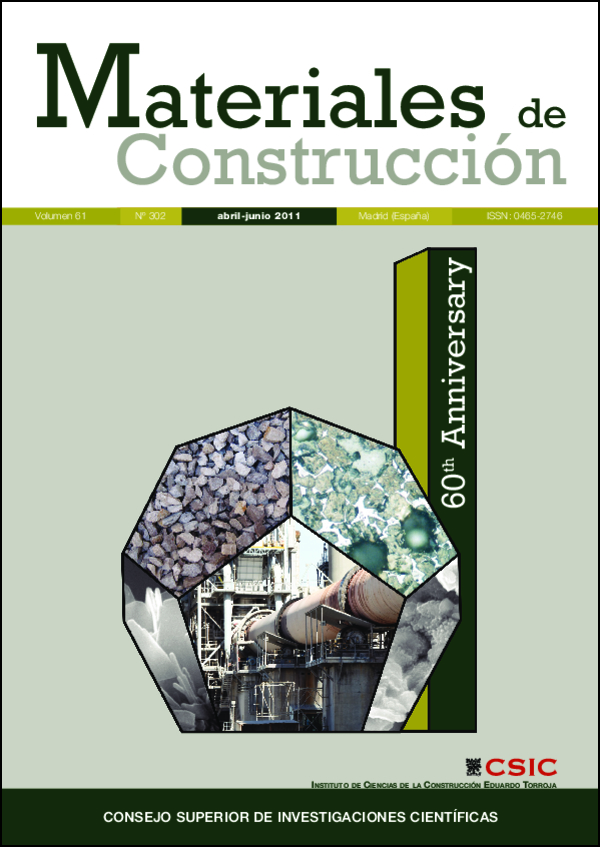Ground granulated blast furnace slag efficiency coefficient (k value) in concrete. Applications and limits
DOI:
https://doi.org/10.3989/mc.2011.60410Keywords:
k-value, ground granulated blast-furnace slag, concrete, EN 206-1, durabilityAbstract
Recently, a k-value for ground granulated blast-furnace slag or k-value has been added to the revision of the European standard EN 206-1:2000. The proposed values during the disscusion in the working groups were very different because in most of cases the compressive strength was the only characteristic considered; while only in few cases the concrete durability was taken into account when ground granulated blast-furnace slag is added directly to the mix. Advantages and disadvantages of the k-values found in the literature are discussed in this paper. The final conclusion may be summarised suggesting a logical proposal of addressing to each country the choice of the k-value in function of the concrete application, environment and placing conditions selected according to their own experience.
Downloads
References
(1) EN 206-1:2000. Concrete - Part 1: Specification, performance, production and conformity. CEN/TC 104. + Resolutions of the CEN/TC 104/SC 1 (Delft 2010-09-15/16).
(2) EHE-2008. Instrucción de Hormigón Estructural. Real Decreto 1247/2008, de 18 de julio, por el que se aprueba la instrucción de hormigón estructural (EHE-08). © Ministerio de Fomento. Spain.
(3) Gruyaert, E.: “Hydration heat and strength development of concrete containing blast-furnace slag”, Ghent University, Belgium.
(4) Iyoda, T.; Dan, Y.; Sagawa, Y.; Hamada, H.: “The effect of curing period on the durability of concrete using blast-furnace slag blended cement”. The 3rd ACF International Conference-ACF/VCA 2008.
(5) Aldea, C. A.; Young, F.; Wang, K.; Shah, S. P.: “Effects of curing conditions on properties of concrete using slag replacement”, Cem. Concr. Res., Volume 30, Issue 3, March 2000, pp. 465-472. http://dx.doi.org/10.1016/S0008-8846(00)00200-3
(6) Atis,, C. D.; Bilim, C.: “Wet and dry cured compressive strength of concrete containing ground granulated blast-furnace slag”, Building and Environment, volume 42, Issue 8, August 2007, pp. 3060-3065.
(7) Ballim, Y.: “Curing and the durability of opc, fly ash and blast-furnace slag concretes”. Materials and Structures/Materiaux et Constructions, May 1993, vol. 26, nº. 158, pp 238-244.
(8) Bouikn, I. A.; Swamy, R. N.; Bali, A.: “Durability properties of concrete containing 50% and 65% slag”. Construction and Building Materials 23 (2009) 2836–2845.
(9) Collepardi, M.; Collepardi, S.; Ogoumah Olagot, J. J.; Simonelli, F.: “The influence of slag and fly ash on the carbonation of concrete”. Eighth CANMET/ACI Int. Conf. on fly ash, silica fume, slag, and natural pozzolans in concrete. Proccedings ACI SP-221-29. Las Vegas, Nevada, USA. 2004. 23-29 de mayo de 2004, pp. 483-493.
(10) Litvan, G. G.; Meyer, A.: “Carbonation of granulated blast furnace slag cementconcrete Turing twenty years of field exposure”. Second Int. Conf. On fly ash, silica fume, slag, and natural pozzolans in concrete. Proccedings ACI SP-91, Madrid, Spain, 1986, pp. 1445-1462.
(11) Sisomphon, K.; Franke, L.: “Carbonation rates of concretes containing high volume of pozzolanic materials”. Cem. Concr. Res., 37 (2007) 1647–1653.
(12) Utgenannt, P.; Luping, T.: CBI - Swedish Cement and Concrete Research Institute. Experience from field exposure in marine and highway environment - Frost resistance, chloride ingress and reinforcement corrosion. 10 years of frost experience at 3 Swedish field exposure sites. Peter Utgenannt (Swedish Cement and Concrete Research Institute, CBI). Erika Holt, Hannele Kuosa, Markku Leivo & Erkki Vesikari. DuraInt-Project Workshop. Effect of interacted deterioration parameters on service life of concrete structures in cold environments. VTT WORKING PAPERS 116. ISBN 978-951-38-7177-2. March 2009. 32 p. VTT Technical Research Centre of Finland. P.O. Box 1000, FI-02044 VTT, Finland.
(13) Giergiczny, Z.; Glinicki, M. A.; Sokol/owski, M.; Zielinski, M.: “Air void system and frost-salt scaling of concrete containing slagblended cement”. Construction and Building Materials 23 (2009) 2451–2456.
(14) Wu, C. H.; Yen, T.; Liu, Y. W.; Hsu, T. H.: “The abrasion erosion resistance of concrete containing blast furnace slag”.
(15) Härdtl, R. T.: “The application of the k-value concept to ground granulated blast furnace slag”. Cement International, 6/2010. vol. 8., pp. 66-73.
Downloads
Published
How to Cite
Issue
Section
License
Copyright (c) 2011 Consejo Superior de Investigaciones Científicas (CSIC)

This work is licensed under a Creative Commons Attribution 4.0 International License.
© CSIC. Manuscripts published in both the print and online versions of this journal are the property of the Consejo Superior de Investigaciones Científicas, and quoting this source is a requirement for any partial or full reproduction.
All contents of this electronic edition, except where otherwise noted, are distributed under a Creative Commons Attribution 4.0 International (CC BY 4.0) licence. You may read the basic information and the legal text of the licence. The indication of the CC BY 4.0 licence must be expressly stated in this way when necessary.
Self-archiving in repositories, personal webpages or similar, of any version other than the final version of the work produced by the publisher, is not allowed.
















